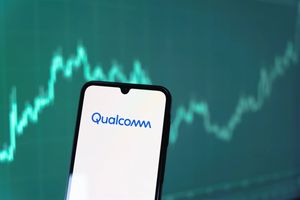
Taiwan Semiconductor Manufacturing Co. (NYSE: TSM), the undisputed behemoth in advanced chip fabrication and a linchpin of the global artificial intelligence (AI) supply chain, sent a jolt of optimism through the U.S. stock market today, October 16, 2025. The company announced exceptionally strong third-quarter 2025 earnings, reporting a staggering 39.1% jump in profit, significantly exceeding analyst expectations. This robust performance, primarily fueled by insatiable demand for cutting-edge AI chips, immediately sent U.S. stock indexes ticking higher, with technology stocks leading the charge and reinforcing investor confidence in the enduring AI megatrend.
The news reverberated across Wall Street, with TSMC's U.S.-listed shares (NYSE: TSM) surging over 2% in pre-market trading and maintaining momentum throughout the day. This surge added to an already impressive year-to-date gain of over 55% for the company's American Depositary Receipts (ADRs). The ripple effect was immediate and widespread, boosting futures for the S&P 500 and Nasdaq 100, and propelling shares of major U.S. chipmakers and AI-linked technology companies. Nvidia (NASDAQ: NVDA) saw gains of 1.1% to 1.2%, Micron Technology (NASDAQ: MU) climbed 2.9% to 3.6%, and Broadcom (NASDAQ: AVGO) advanced by 1.7% to 1.8%, underscoring TSMC's critical role in powering the next generation of AI innovation.
The Microscopic Engine of the AI Revolution: TSMC's Advanced Process Technologies
TSMC's dominance in advanced chip manufacturing is not merely about scale; it's about pushing the very limits of physics to create the microscopic engines that power the AI revolution. The company's relentless pursuit of smaller, more powerful, and energy-efficient process technologies—particularly its 5nm, 3nm, and upcoming 2nm nodes—is directly enabling the exponential growth and capabilities of artificial intelligence.
The 5nm process technology (N5 family), which entered volume production in 2020, marked a significant leap from the preceding 7nm node. Utilizing extensive Extreme Ultraviolet (EUV) lithography, N5 offered up to 15% more performance at the same power or a 30% reduction in power consumption, alongside a 1.8x increase in logic density. Enhanced versions like N4P and N4X have further refined these capabilities for high-performance computing (HPC) and specialized applications.
Building on this, TSMC commenced high-volume production for its 3nm FinFET (N3) technology in 2022. N3 represents a full-node advancement, delivering a 10-15% increase in performance or a 25-30% decrease in power consumption compared to N5, along with a 1.7x logic density improvement. Diversified 3nm offerings like N3E, N3P, and N3X cater to various customer needs, from enhanced performance to cost-effectiveness and HPC specialization. The N3E process, in particular, offers a wider process window for better yields and significant density improvements over N5.
The most monumental leap on the horizon is TSMC's 2nm process technology (N2 family), with risk production already underway and mass production slated for the second half of 2025. N2 is pivotal because it marks the transition from FinFET transistors to Gate-All-Around (GAA) nanosheet transistors. Unlike FinFETs, GAA nanosheets completely encircle the transistor's channel with the gate, providing superior control over current flow, drastically reducing leakage, and enabling even higher transistor density. N2 is projected to offer a 10-15% increase in speed or a 20-30% reduction in power consumption compared to 3nm chips, coupled with over a 15% increase in transistor density. This continuous evolution in transistor architecture and lithography, from DUV to extensive EUV and now GAA, fundamentally differentiates TSMC's current capabilities from previous generations like 10nm and 7nm, which relied on less advanced FinFET and DUV technologies.
The AI research community and industry experts have reacted with profound optimism, acknowledging TSMC as an indispensable foundry for the AI revolution. TSMC's ability to deliver these increasingly dense and efficient chips is seen as the primary enabler for training larger, more complex AI models and deploying them efficiently at scale. The 2nm process, in particular, is generating high interest, with reports indicating it will see even stronger demand than 3nm, with approximately 10 out of 15 initial customers focused on HPC, clearly signaling AI and data centers as the primary drivers. While cost concerns persist for these cutting-edge nodes (with 2nm wafers potentially costing around $30,000), the performance gains are deemed essential for maintaining a competitive edge in the rapidly evolving AI landscape.
Symbiotic Success: How TSMC Powers Tech Giants and Shapes Competition
TSMC's strong earnings and technological leadership are not just a boon for its shareholders; they are a critical accelerant for the entire U.S. technology sector, profoundly impacting the competitive positioning and product roadmaps of major AI companies, tech giants, and even emerging startups. The relationship is symbiotic: TSMC's advancements enable its customers to innovate, and their demand fuels TSMC's growth and investment in future technologies.
Nvidia (NASDAQ: NVDA), the undisputed leader in AI acceleration, is a cornerstone client, heavily relying on TSMC for manufacturing its cutting-edge GPUs, including the H100 and future architectures like Blackwell. TSMC's ability to produce these complex chips with billions of transistors (Blackwell chips contain 208 billion transistors) is directly responsible for Nvidia's continued dominance in AI training and inference. Similarly, Apple (NASDAQ: AAPL) is a massive customer, leveraging TSMC's advanced nodes for its A-series and M-series chips, which increasingly integrate sophisticated on-device AI capabilities. Apple reportedly uses TSMC's 3nm process for its M4 and M5 chips and has secured significant 2nm capacity, even committing to being the largest customer at TSMC's Arizona fabs. The company is also collaborating with TSMC to develop its custom AI chips, internally codenamed "Project ACDC," for data centers.
Qualcomm (NASDAQ: QCOM) depends on TSMC for its advanced Snapdragon chips, integrating AI into mobile and edge devices. AMD (NASDAQ: AMD) utilizes TSMC's advanced packaging and leading-edge nodes for its next-generation data center GPUs (MI300 series) and EPYC CPUs, positioning itself as a strong challenger in the high-performance computing (HPC) and AI markets. Even Intel (NASDAQ: INTC), which has its own foundry services, relies on TSMC for manufacturing some advanced components and is exploring deeper partnerships to boost its competitiveness in the AI chip market.
Hyperscale cloud providers like Alphabet's Google (NASDAQ: GOOGL) and Amazon (NASDAQ: AMZN) (AWS) are increasingly designing their own custom AI silicon (ASICs) – Google's Tensor Processing Units (TPUs) and AWS's Inferentia and Trainium chips – and largely rely on TSMC for their fabrication. Google, for instance, has transitioned its Tensor processors for future Pixel phones from Samsung to TSMC's N3E process, expecting better performance and power efficiency. Even OpenAI, the creator of ChatGPT, is reportedly working with Broadcom (NASDAQ: AVGO) and TSMC to develop its own custom AI inference chips on TSMC's 3nm process, aiming to optimize hardware for unique AI workloads and reduce reliance on external suppliers.
This reliance means TSMC's robust performance directly translates into faster innovation and product roadmaps for these companies. Access to TSMC's cutting-edge technology and massive production capacity (thirteen million 300mm-equivalent wafers per year) is crucial for meeting the soaring demand for AI chips. This dynamic reinforces the leadership of innovators who can secure TSMC's capacity, while creating substantial barriers to entry for smaller firms. The trend of major tech companies designing custom AI chips, fabricated by TSMC, could also disrupt the traditional market dominance of off-the-shelf GPU providers for certain workloads, especially inference.
A Foundational Pillar: TSMC's Broader Significance in the AI Landscape
TSMC's sustained success and technological dominance extend far beyond quarterly earnings; they represent a foundational pillar upon which the entire modern AI landscape is being constructed. Its centrality in producing the specialized, high-performance computing infrastructure needed for generative AI models and data centers positions it as the "unseen architect" powering the AI revolution.
The company's estimated 70-71% market share in the global pure-play wafer foundry market, intensifying to 60-70% in advanced nodes (7nm and below), underscores its indispensable role. AI and HPC applications now account for a staggering 59-60% of TSMC's total revenue, highlighting how deeply intertwined its fate is with the trajectory of AI. This dominance accelerates the pace of AI innovation by enabling increasingly powerful and energy-efficient chips, dictating the speed at which breakthroughs can be scaled and deployed.
TSMC's impact is comparable to previous transformative technological shifts. Much like Intel's microprocessors were central to the personal computer revolution, or foundational software platforms enabled the internet, TSMC's advanced fabrication and packaging technologies (like CoWoS and SoIC) are the bedrock upon which the current AI supercycle is built. It's not merely adapting to the AI boom; it is engineering its future by providing the silicon that enables breakthroughs across nearly every facet of artificial intelligence, from cloud-based models to intelligent edge devices.
However, this extreme concentration of advanced chip manufacturing, primarily in Taiwan, presents significant geopolitical concerns and vulnerabilities. Taiwan produces around 90% of the world's most advanced chips, making it an indispensable part of global supply chains and a strategic focal point in the US-China tech rivalry. This creates a "single point of failure," where a natural disaster, cyber-attack, or geopolitical conflict in the Taiwan Strait could cripple the world's chip supply with catastrophic global economic consequences, potentially costing over $1 trillion annually. The United States, for instance, relies on TSMC for 92% of its advanced AI chips, spurring initiatives like the CHIPS and Science Act to bolster domestic production. While TSMC is diversifying its manufacturing locations with fabs in Arizona, Japan, and Germany, Taiwan's government mandates that cutting-edge work remains on the island, meaning geopolitical risks will continue to be a critical factor for the foreseeable future.
The Horizon of Innovation: Future Developments and Looming Challenges
The future of TSMC and the broader semiconductor industry, particularly concerning AI chips, promises a relentless march of innovation, though not without significant challenges. Near-term, TSMC's N2 (2nm-class) process node is on track for mass production in late 2025, promising enhanced AI capabilities through faster computing speeds and greater power efficiency. Looking further, the A16 (1.6nm-class) node is expected by late 2026, followed by the A14 (1.4nm) node in 2028, featuring innovative Super Power Rail (SPR) Backside Power Delivery Network (BSPDN) for improved efficiency in data center AI applications. Beyond these, TSMC is preparing for its 1nm fab, designated as Fab 25, in Shalun, Tainan, as part of a massive Giga-Fab complex.
As traditional node scaling faces physical limits, advanced packaging innovations are becoming increasingly critical. TSMC's 3DFabric family, including CoWoS, InFO, and TSMC-SoIC, is evolving. A new chip packaging approach replacing round substrates with square ones is designed to embed more semiconductors in a single chip for high-power AI applications. A CoWoS-based SoW-X platform, delivering 40 times more computing power, is expected by 2027. The demand for High Bandwidth Memory (HBM) for these advanced packages is creating "extreme shortages" for 2025 and much of 2026, highlighting the intensity of AI chip development.
family, including CoWoS, InFO, and TSMC-SoIC, is evolving. A new chip packaging approach replacing round substrates with square ones is designed to embed more semiconductors in a single chip for high-power AI applications. A CoWoS-based SoW-X platform, delivering 40 times more computing power, is expected by 2027. The demand for High Bandwidth Memory (HBM) for these advanced packages is creating "extreme shortages" for 2025 and much of 2026, highlighting the intensity of AI chip development.
Beyond silicon, the industry is exploring post-silicon technologies and revolutionary chip architectures such as silicon photonics, neuromorphic computing, quantum computing, in-memory computing (IMC), and heterogeneous computing. These advancements will enable a new generation of AI applications, from powering more complex large language models (LLMs) in high-performance computing (HPC) and data centers to facilitating autonomous systems, advanced Edge AI in IoT devices, personalized medicine, and industrial automation.
However, critical challenges loom. Scaling limits present physical hurdles like quantum tunneling and heat dissipation at sub-10nm nodes, pushing research into alternative materials. Power consumption remains a significant concern, with high-performance AI chips demanding advanced cooling and more energy-efficient designs to manage their substantial carbon footprint. Geopolitical stability is perhaps the most pressing challenge, with the US-China rivalry and Taiwan's pivotal role creating a fragile environment for the global chip supply. Economic and manufacturing constraints, talent shortages, and the need for robust software ecosystems for novel architectures also need to be addressed.
Industry experts predict an explosive AI chip market, potentially reaching $1.3 trillion by 2030, with significant diversification and customization of AI chips. While GPUs currently dominate training, Application-Specific Integrated Circuits (ASICs) are expected to account for about 70% of the inference market by 2025 due to their efficiency. The future of AI will be defined not just by larger models but by advancements in hardware infrastructure, with physical systems doing the heavy lifting. The current supply-demand imbalance for next-generation GPUs (estimated at a 10:1 ratio) is expected to continue driving TSMC's revenue growth, with its CEO forecasting around mid-30% growth for 2025.
A New Era of Silicon: Charting the AI Future
TSMC's strong Q3 2025 earnings are far more than a financial triumph; they are a resounding affirmation of the AI megatrend and a testament to the company's unparalleled significance in the history of computing. The robust demand for its advanced chips, particularly from the AI sector, has not only boosted U.S. tech stocks and overall market optimism but has also underscored TSMC's indispensable role as the foundational enabler of the artificial intelligence era.
The key takeaway is that TSMC's technological prowess, from its 3nm and 5nm nodes to the upcoming 2nm GAA nanosheet transistors and advanced packaging innovations, is directly fueling the rapid evolution of AI. This allows tech giants like Nvidia, Apple, AMD, Google, and Amazon to continuously push the boundaries of AI hardware, shaping their product roadmaps and competitive advantages. However, this centralized reliance also highlights significant vulnerabilities, particularly the geopolitical risks associated with concentrated advanced manufacturing in Taiwan.
TSMC's impact is comparable to the most transformative technological milestones of the past, serving as the silicon bedrock for the current AI supercycle. As the company continues to invest billions in R&D and global expansion (with new fabs in Arizona, Japan, and Germany), it aims to mitigate these risks while maintaining its technological lead.
In the coming weeks and months, the tech world will be watching for several key developments: the successful ramp-up of TSMC's 2nm production, further details on its A16 and 1nm plans, the ongoing efforts to diversify the global semiconductor supply chain, and how major AI players continue to leverage TSMC's advancements to unlock unprecedented AI capabilities. The trajectory of AI, and indeed much of the global technology landscape, remains inextricably linked to the microscopic marvels emerging from TSMC's foundries.
This content is intended for informational purposes only and represents analysis of current AI developments.
TokenRing AI delivers enterprise-grade solutions for multi-agent AI workflow orchestration, AI-powered development tools, and seamless remote collaboration platforms.
For more information, visit https://www.tokenring.ai/.





